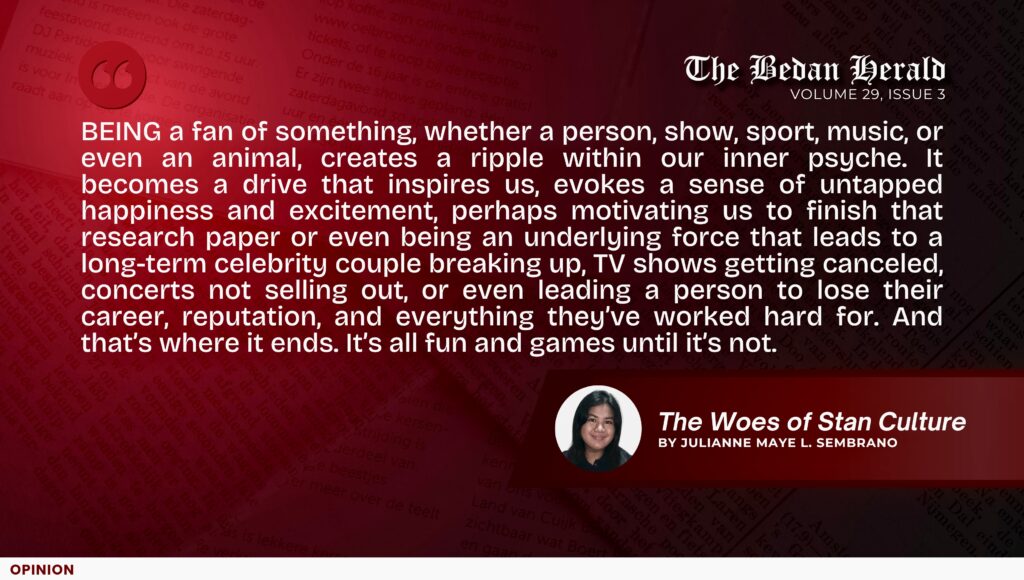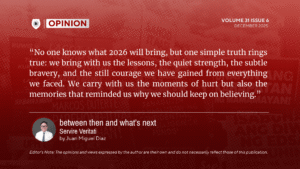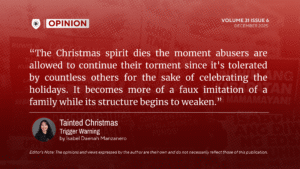By Julianne Maye L. Sembrano | February 18, 2024
The Woes of Stan Culture
BEING a fan of something, whether a person, show, sport, music, or even an animal, creates a ripple within our inner psyche. It becomes a drive that inspires us, evokes a sense of untapped happiness and excitement, perhaps motivating us to finish that research paper or even being an underlying force that leads to a long-term celebrity couple breaking up, TV shows getting canceled, concerts not selling out, or even leading a person to lose their career, reputation, and everything they’ve worked hard for. And that’s where it ends. It’s all fun and games until it’s not.
'Stan,' a word that combines 'stalker' and 'fan,' is a made-up term that originated from a particular rap song once upon a time. Leave it to the internet to twist that word and somehow make it a universally positive term everyone uses. It is now used as a definition of being a fan of something or an enthusiast. And with that said, they are the backbone of social media.
The celebrities, personalities, shows, and sports you enjoy today thrive because of the people who rally behind them. They share positive words of encouragement, create stories, and make videos that break down the structure of what makes it worth loving in the first place. People, or stans rather, will do everything in their power to unite under a common goal, whether to send love, send donations, and send peace and fulfillment to those who need it. But… What happens if they unite to do the opposite?
That’s where performative activism and parasocial relationships enter the fray. When we put these people, who are humans just like us, on such a high pedestal, we ask for more than the bare minimum from them. A simple Instagram post that says they support Group A and not Group B will garner positive and negative reactions. Posting a black square with a link on their Instagram story to donate to an important cause will also do the same. So, who are they supposed to side with? The answer is simple: No one. Behind them are probably managers and Public Relations (PR) teams who do the work for them.
However, the issue with performative activism and parasocial relationships runs deeper than just social media reactions and screams of praise from their stans. It's about the impact on society as a whole. Since behind that same screen you are aimlessly scrolling on are people who are suffering the real-life consequences of the actions made by the people that you adore. When highly regarded individuals engage in performative activism, they may only fully understand the complexities of the issues they are addressing. This can lead to shallow, ineffective actions, actually failing to bring about meaningful change.
On the other hand, not all artists are like this, as many still use their platforms and resources to make genuine contributions to social causes, whether through donations, advocacy, or direct action. To the point that their fans are giving to the cause. Even so, it further alludes to the idea that parasocial relationships create unrealistic expectations and boundaries between fans and the individuals they idolize, blurring the lines between reality and fantasy. Disappointment is out to get us one way or another, and the people whom we look up to may not be as they seem, whether we are in denial or not.
And that's where the thin line of stan culture ends. It's always meant to be light-hearted fun. It is a silly little thing that will keep you entertained and distracted from the harsh realities of life. At the end of the day, your celebrities will not save you, nor will they save the world— but they will always be a reminder that a means of escape is always present. We will experience love from them momentarily, but when it's time to face reality, we must learn to let go, move on, and start ‘stanning’ ourselves.
Volume 29 | Issue 3




